State defense force

State defense forces (SDF; also known as state guards, state military reserves, or state militias) in the United States are military units that operate under the sole authority of a state government; they are partially regulated by the National Guard Bureau but they are not a part of the Army National Guard of the United States.[1] State defense forces are authorized by state and federal law and are under the command of the governor of each state.
State defense forces are distinct from their state's National Guard in that they cannot become federal entities. All state National Guard personnel (to include the National Guard of the District of Columbia, the Commonwealth of Puerto Rico and the territories of Guam and the Virgin Islands) can be federalized under the National Defense Act of 1933 with the creation of the National Guard of the United States. This provides the basis for integrating units and personnel of the Army National Guard into the U.S. Army and, since 1947, units and personnel of the Air National Guard into the U.S. Air Force.[2]
The federal government recognizes state defense forces, as per the Compact Clause of the U.S. Constitution, under 32 U.S.C. § 109 which provides that state defense forces as a whole may not be called, ordered, or drafted into the armed forces of the United States, thus preserving their separation from the National Guard. However, under the same law, individual members serving in the state defense force are not exempt from service in the armed forces (i.e., they are not excluded from the draft). Under 32 USC § 109(e), "A person may not become a member of a defense force ... if he is a member of a reserve component of the armed forces."
Nearly every state has laws authorizing state defense forces, and 22 states, plus the Commonwealth of Puerto Rico, have active SDFs with different levels of activity, support, and strength. State defense forces generally operate with emergency management and homeland security missions. Most SDFs are organized as army units, but air and naval units also exist.[3][4] As governors often use state defense forces to augment their state's Army National Guard and Air National Guard units, state defense forces have been both officially and informally called National Guard Reserves.[5]
History
Origins
From its founding until the early 1900s, the United States maintained only a minimal army and relied on state militias to supply the majority of its troops, with the training and readiness of the latter varying widely.[6] As a result of the Spanish–American War and the performance of the militias and other volunteer units during that conflict, Congress was called upon to reform and regulate the training and qualification of state militias. In 1903, with passage of the Dick Act, the predecessor to the modern-day National Guard was formed. It required the states to divide their militias into two sections. The law recommended the title "National Guard" for the first section, known as the organized militia, and "Reserve Militia" for all others.[7]
During World War I, Congress authorized the states to maintain Home Guards, which were reserve forces outside the National Guard forces that were then being deployed by the Federal Government as part of the National Army. The Secretary of War was authorized to furnish these Home Guard units with rifles, ammunition, and supplies.[8]
In 1933, Congress finalized the split between the National Guard and the traditional state militias by mandating that all federally funded soldiers take a dual enlistment/commission and thus enter both the state National Guard and the newly created National Guard of the United States, a federal reserve force. In 1940, with the onset of World War II and as a result of its federalizing the National Guard, Congress amended the National Defense Act of 1916, and authorized the states to maintain "military forces other than National Guard."[9] This law authorized the War Department to train and arm the new military forces that would come to be known as State Guards. Many states took advantage of this law and maintained distinct state military forces throughout the war to defend their own territories, shorelines, and air spaces. In 1947, with the establishment of an independent U.S. Air Force, Congress directed yet another reorganization of the National Guard into a separate Army National Guard and a separate Air National Guard. The former would continue to be composed of traditional Army ground units and those aviation assets (certain helicopters and observation/liaison aircraft) unique to Army Aviation, while the latter would consist of those National Guard units that had heretofore been part of the former U.S. Army Air Forces and would now be operationally gained by the newly established Air Force.
Cold War
In 1950, with the outbreak of the Korean War and at the urging of the National Guard, Congress reauthorized the separate state military forces for a time period of two years. These state military forces were authorized military training at federal expense, as well as "arms, ammunition, clothing, and equipment," as deemed necessary by the Secretary of the Army.[10] At the end of the two years, however, they were not reauthorized under federal law.
In 1956, Congress finally revised the law and authorized "State defense forces" permanently under Title 32, Section 109, of the United States Code.[11] Two years later, Congress amended the law and changed the name from "State defense forces" to "defense forces."[12] Still, it was not until the early Ronald Reagan administration that many states developed their defense forces into elements that existed beyond paper, when the U.S. Department of Defense actively encouraged states to create and maintain SDF units.[13]
By the late 1980s, however, a series of high-profile reports caused several states to shut down or significantly restructure their forces. In 1987, the governor of Utah removed all but 31 officers from its state defense force, the Utah State Guard, after a probe revealed that its ranks were "peppered with neo-Nazis, felons and mental patients."[14] Meanwhile, in 1990, the Virginia General Assembly launched an investigation and subsequent overhaul of its state's force after receiving tips that the volunteers were "saving money to buy a tank."[15]
Modern era
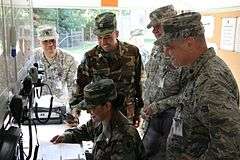
With the end of the Cold War came a general decrease of interest in state defense forces. The attacks of September 11, 2001, however, generated additional attention and, with it, greater scrutiny from some in the United States military who questioned the training and equipment of the units and whether they provided an outlet for "warrior wannabes" who would not otherwise qualify for service in the armed forces.[16] In 2008, Alaska disarmed its state defense force after an investigation concluded the lack of training intensity or standardization was a potential legal liability to the state.[17] By 2010 the status of the force had been downgraded even further, with the Adjutant-General of the Alaska National Guard informing volunteers that they would only be called upon as a "reserve of last resort to be used only in the most extreme emergencies.”[18]
Further controversy was stoked by a New York Times report which found many senior officers in the New York Guard had little or no formal military training despite holding, in some cases, general officer ranks. The former commander of the force, Pierre David Lax, noted that, "if you are friendly with the governor and you always wanted to be a general, you ask the governor to make you a general, and poof, you are a brigadier general." Another former commander asserted he regularly awarded titles to members of the New York legislature in exchange for their support of budgetary allocations to the force. The report also noted that a majority of the unit's rare deployments involved providing ceremonial support, such as bands and color guards, to the state government.[19]
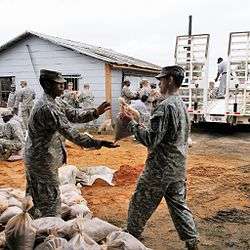
An April 2014 Department of Defense report by the Inspector General's office reported confusion and inconsistency among state adjutant generals as to the use and status of state defense forces. The IG's office reported an under-utilization of state defense force capabilities due to a lack of clarity in US code regarding the use of SDFs, fueling fear that using funds and assets acquired through the federal government for state defense forces could run afoul of regulations. (While the National Guard is operated by the states, most of their equipment and funding comes from the federal government.) This fear of violating regulations also inhibited their use and integration with their National Guard counterparts, preventing them from conducting joint operations alongside one another, and also from volunteering in support of federally run missions. Other problems cited by the Inspector General's office were a lack of standardization in training and physical fitness, raising questions as to the ability of SDFs to work alongside their National Guard counterparts, and a lack of coordination with and support from the Department of Defense. During a survey conducted by the Inspector General of SDF commanders and adjutant generals, 18 of 19 considered their SDFs to be part of the organized militia and subject to the Code of Military Justice, 14 of 18 considered the members of SDFs to be "soldiers", 14 of 18 considered SDF personnel to be "lawful belligerents" under the rules of war, and only 4 of 19 authorized their personnel to conduct firearms training. Almost all of the missions reported to the IG's office were non-military in nature, including small-scale search and rescue, disaster management, and other unarmed, homeland security related-tasks.[20]
Due to public fears over the Jade Helm 15 exercises held throughout a number of southwestern states, on April 28, 2015, Gov. Greg Abbott of Texas ordered a call-up of the Texas State Guard to monitor the exercises and facilitate communication between US special operations forces conducting training and the governor's office.[21]
Future
A 2003 article in the United States Army War College's Parameters journal recommended that "United States Northern Command (NORTHCOM) should ensure that future contingency planning efforts for homeland security operations fully incorporate the valuable capabilities that State Defense Forces can provide." [22] In the decade following that article, however, no significant action has been taken on the recommendation.
Several bills have been unsuccessfully introduced in Congress since the early 1990s seeking to improve the readiness of state defense forces. The most recent, H.R. 206, introduced in 2009 by Rep. Joe Wilson of South Carolina, would have allowed the U.S. Secretary of Defense to transfer surplus U.S. military equipment to state defense forces. Co-sponsors of the bill included Jim Marshall and Frank Wolf. Congress took no action on the measure before adjourning.[23]
Active state defense forces
There are currently 21 active state defense forces. A 2005 Department of Defense report reported twenty-three active SDFs in the United States and Puerto Rico.[24] Since this time, New Jersey has suspended its State Defense Force.[25] Per National Guard Regulation 10-4: "Any State, Territory, or District of Columbia, that creates a SDF under 32 USC §109 is solely responsible for the establishment, organization, training, equipping, funding, management and employment of that SDF in accordance with (IAW) its laws"[1]
The Puerto Rico State Guard includes an air support component., the 1st Air Base Group, that support the operations of the Puerto Rico Air National Guard.
The Texas State Guard's Air Component Command supports the Texas Air National Guard and provides Defense Support to Civil Authorities, (DSCA).[26]
The following is a list of active SDFs in the United States and Puerto Rico:

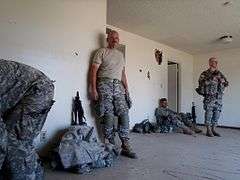


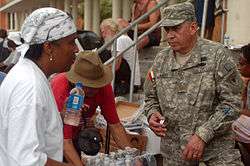
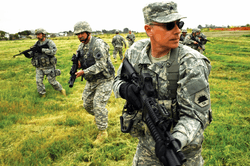
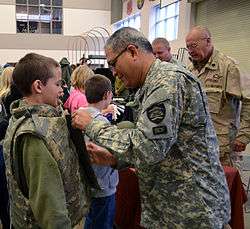
* Colorado does not operate an active state defense force, but rather has a statutory state defense force staffed by one individual appointed by the governor.
Structure
Personnel and training
Some state defense forces have minimal enlistment requirements, permitting virtually any citizen under a prescribed age (usually 66) to join, even if they have no previous military experience, or don't meet conventional military physical standards (California, for instance, requires no physical fitness test prior to entry and has weight/height standards significantly more relaxed than the U.S. military).[106] Others, such as Tennessee, normally require personnel to have been honorably discharged from the U.S. military, or have a professional background in a critical skill such as engineering or medicine.[107]
Many state defense forces allow enlistment "at will" and personnel are under no termed service obligation, unlike most conventional military forces, meaning they can simply quit at any time without facing charges of desertion or Absence Without Leave.

Training standards vary widely, but usually require only 15 days of annual drill, compared to the absolute minimum of 38 days (if not more) required of most federal military reserve forces. Unlike the U.S. military, there is generally only a limited period of basic training, often as few as four days for persons with no prior military experience, significantly less than the ten weeks of basic training required, for instance, by the United States Army.
The Military Emergency Management Specialist (MEMS) qualification created by the State Guard Association of the United States has become a common training focal point among state defense forces. Alabama, California, Indiana, Ohio and others have adopted the MEMS Badge as a basic qualification required of all members desiring promotion. Training is conducted both online, and through MEMS academies in each state, and includes course material provided by FEMA and other agencies, as well as practical experience in local disaster planning and exercise management.[108]
Community Emergency Response Teams (CERTs) are being organized by several SDFs by utilizing training offered by the Federal Emergency Management Agency's Citizen Corps. Some states follow the lead of the Army and offer a permanent tab (worn in a similar manner as the Army's Ranger and Sapper tabs) as an incentive to become certified as part of the local or unit CERT team.
State defense forces may incorporate Medical Reserve Corps units into their organizational structure. The 47th Medical Company of the New Mexico State Guard,[109] the 10th Medical Regiment of the Maryland Defense Force,[110] and the Medical Brigade of the Texas State Guard[111] receive training and recognition from the Medical Reserve Corps program sponsored by the Office of the Surgeon General of the United States through the Citizen Corps program, and are simultaneously organized as units of their respective state defense force.
Weapons qualification and training is provided in some SDFs. However, most SDFs do not require weapons proficiency. A 2006 report by the U.S. Freedom Foundation, an organization affiliated with the State Guard Association of the United States,[112] recommended minimum standards for state defense forces, including weapons training, but the report has been largely ignored. Some SDFs have laws that in the event of deployment by order of the state legislature and/or governor, they will become armed.
Organization

Many states organize their state defense force parallel to their National Guard (both Air and Army), having them report to the governor through the state's adjutant general. State defense forces are not funded by the federal government, and in most states members are unpaid. Volunteers have to purchase their own uniforms and most, if not all, of their own equipment.
Because many members of state defense forces are veterans who have retained ranks received from service in the armed forces, some state defense forces have an inflated grade structure. Advocates reply that the grades worn by state defense force members accurately reflect the many years of experience that veterans (often military or naval retirees) bring to the state forces. Some SDF soldiers use the two-letter state abbreviation in parenthesis after their rank to indicate the origin of their grade. For example, a major in the California State Military Reserve would give his or her rank as "MAJ (CA)." However, numerous states do not practice this notation because many senior commissioned and noncommissioned officers earned their rank while serving at the federal level. Moreover, Army regulations require the service branch title to appear after the rank and name (e.g., COL John S. Smith, CSMR).
While in the past, many state defense forces were organized as military police brigades or infantry brigades, the experiences of recent events such as Hurricane Katrina has changed attitudes and plans. Civil affairs units and medical units now predominate in some states. Organization levels may be inflated: a battalion may have less than 100 members, and a state defense force brigade may have less than 300 soldiers.
Uniforms

As a general rule, state defense forces wear standard U.S. military uniforms with insignia closely matching those of their federal counterparts. SDF units generally wear red name tags on service uniforms (as specifically prescribed by AR 670-1[113] for SDF units when adopting the Army Service Uniform or Battle Dress Uniform (BDU), and name tapes on Army Combat Uniform (ACU) or BDU uniforms use the state defense force name or state name rather than "U.S. Army." Standard U.S. Army branch insignia are often used or a unique "state guard" branch insignia consisting of a crossed musket and sword is alternatively used.
Where berets are worn, some state defense forces use a beret flash similar to the one the U.S. Army uses, but in bright red thread instead of the Army's blue. Other states have beret flashes based on the state flag. State soldiers in the New York Guard formerly wore a grey beret flash. (Wear of the beret by New York Guard soldiers has been discontinued, replaced by a black patrol cap.)[114]
Uniforms vary from state to state and tend to have only subtle differences. For example, the Texas State Guard wears standard U.S. Army camouflage uniforms, a state guard unit patch, and the "U.S. Army" name tape replaced with one reading "Texas State Guard." Similarly, the California State Military Reserve wears a uniform identical to their National Guard counterparts except for the unit patch, beret flash, and the "California" name tape. Outer garments such as a Gore-Tex jacket have a subdued "CA" beneath the rank insignia.[115] A similar pattern can be found in the New York Guard. The Georgia State Defense Force often works in tandem with and support of federal troops. The Georgia State Defense Force wears the ACU with a unique Georgia SDF red flash on the U.S. Army's black beret and "Georgia" in place of the "U.S. Army" uniform name tape. The Tennessee State Guard and Alabama State Defense Force can wear either BDU's or the "tactical response uniform" (TRU)[116] in the Woodland pattern but whose cut and accouterments match the ACU but cannot mix pieces. The Alabama State Defense Force has also recently introduced a new "Standard Service Uniform" composed of a blue "tactical" shirt, and khaki "tactical" pants.[117]
The few states with both SDF air and naval units wear modified USAF and USN/USMC uniforms. Currently, only Ohio, Alaska and New York have uniformed naval militias. Only California, Texas, Vermont, and Puerto Rico have an air wing, though Indiana formerly had an Air Guard Reserve. In all cases, the state adjutant general has final say on uniforms worn by state defense forces, though federal service regulations generally shape the policies of each state.
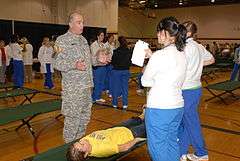





| Force | Branch Tape Reads | Branch & Name Tape colors | Insignia | Head Covering | Uniform Type |
|---|---|---|---|---|---|
| Alabama State Defense Force[27] | ALABAMA[117] | White on red[117] | Subdued[117] | Patrol cap with unsubdued insignia[117] None, optional baseball cap[117] |
BDU & TRU[117] Navy blue tactical shirt, khaki tactical pants[117] |
| Alaska State Defense Force[29] | ALASKA | Black on ACU | Black on ACU | ACU patrol cap | ACU |
| California State Military Reserve[34] | CALIFORNIA[115] | Black on ACU Blue on ABU |
Black on ACU | ACU patrol cap ABU patrol cap |
ACU ABU |
| Georgia State Defense Force[118] | GEORGIA | Black on ACU | Black on ACU | ACU patrol cap Black beret with red flash for special occasions |
ACU |
| Indiana Guard Reserve[49] | INDIANA | Black on ACU | Black on ACU | Black patrol cap | ACU |
| Maryland Defense Force[56] | MARYLAND | Black on ACU | Black on ACU | ACU patrol cap with "Maryland" on back | ACU |
| Massachusetts State Defense Force[58] | Massachusetts[119] | Black on ACU | Black on ACU | ACU patrol cap | ACU |
| Michigan Volunteer Defense Force[120] | MICHIGAN | Black on ACU | Black on ACU | ACU patrol cap | ACU |
| Mississippi State Guard[63] | MS STATE GUARD | Black on ACU | Black on ACU | Patrol cap & subdued insignia Black beret w/red flash |
ACU |
| New York Guard[75] | N.Y. GUARD | Black on grey (ACU) Black on olive drab (BDU) |
Black on grey (ACU) Black on olive drab (BDU) |
Black patrol cap w/bright rank insignia Black beret w/ gray flash (Dress Blues Only) |
ACU (BDU authorized until 30 September 2013)[121] |
| New York Naval Militia[76] | N.Y. NAVAL MILITIA | Yellow on NWU Black on MARPAT White on blue |
Yellow on NWU Black on MARPAT White on blue |
Naval style 8-point cover Marine style 8-point cover baseball cap |
NWU/MARPAT/ODU |
| Ohio Military Reserve[81] | OHIO | Black on olive drab | Black on olive drab | Patrol cap | BDU/TRU |
| Ohio Naval Militia[4] | OHIO NAVY | Gold/silver on navy blue | Gold/silver on navy blue (E-4 & up) | Naval style 8-point cover | NWU |
| Oregon State Defense Force[122] | OREGON | Black on ACU | Black on ACU | ACU patrol cap with subdued insignia | ACU |
| Puerto Rico State Guard[87] | PRSG ARMY PRSG AIR FORCE |
Black on ACU | Black on ACU | Black beret with yellow & red flash reminiscent of Spanish heraldry | ACU |
| South Carolina State Guard[89] | S.C. STATE GUARD | Black on ACU | Black on ACU | ACU Patrol Cap | ACU |
| Tennessee State Guard[92] | TN ST GUARD | Black on olive drab | Black on olive drab | Black beret with red flash | TRU |
| Texas State Guard[3] | TEXAS STATE GUARD | Black on olive drab/ACU (Army) | Black on olive drab/ACU | Patrol cap | ACU |
| Texas State Guard Maritime Regiment[94] | TEXAS STATE GUARD | Black on MARPAT | Black on MARPAT | Eight-point naval cover | DDCUU |
| Vermont State Guard[123] | VT STATE GUARD | Black on olive drab | Black on olive drab | patrol cap | BDU |
| Virginia Defense Force[99] | VA. DEF. FORCE | Black on olive drab | Black on olive drab | patrol cap | BDU/TRU |
| Washington State Guard[101] | WASHINGTON | Black on ACU | Black on ACU | patrol cap or beret with green flash | ACU |
Special units

SDFs include a variety of special units including medical, aviation, and ceremonial units. The following are examples:
- Cyber Security Command, Maryland Defense Force[124][125]
- Cavalry Troop A, Maryland Defense Force[126]
- 121st Engineer Regiment, Maryland Defense Force
- 10th Medical Regiment, Maryland Defense Force
- Judge Advocate Corps, Maryland Defense Force[127]
- Maryland Defense Force Band
- Governor's Foot Guard, Governor's Horse Guard & Band, Connecticut State Militia[128]
- Georgia State Defense Force Band[129]
- 1st Medical Company, Georgia State Defense Force[130]
- 1st Platoon – DECON/CBRN-e[131]
- Oregon State Defense Force Pipe Band[132]
- Texas State Guard Medical Brigade[133]
- Quick Reaction Teams (QRT) (now disbanded) – Small units attached to a number of Texas State Guard Civil Affairs (CA) regiments. QRT undergo specialized training and qualify with approved NATO 9mm sidearm. QRT compete in the Governor's Twenty competition with the Texas Army National Guard and Texas Air National Guard.
- Small Arms Training Team – Small arms and crew served weapons team of the California State Military Reserve[134]
- Search and Rescue Company, Puerto Rico State Guard
- The 1st Air Base Group, Puerto Rico Air State Guard
- Special Operations (SAR) Branch, Tennessee State Guard
- RAIDER School, South Carolina State Guard[135]
Federal activation
The U.S. Constitution, coupled with several statutes and cases, details the relationship of state defense forces to the federal government. Outside of 32 USC 109, the U.S. Supreme Court noted: "It is true that the state defense forces 'may not be called, ordered, or drafted into the armed forces.' 32 U.S.C. 109(c). It is nonetheless possible that they are subject to call under 10 U.S.C. 331–333, which distinguish the 'militia' from the 'armed forces,' and which appear to subject all portions of the 'militia' – organized or not – to call if needed for the purposes specified in the Militia Clauses" (Perpich v. Department of Defense, 496 U.S. 334 (1990)). The Court, however, explicitly noted that it was not deciding this issue.[136] The following is an extract of the laws which the Court cited as possibly giving the federal government authority to activate the state defense forces:
10 USC 331 – "Federal aid for State governments"
Whenever there is an insurrection in any State against its government, the President may, upon the request of its legislature or of its governor if the legislature cannot be convened, call into Federal service such of the militia of the other States, in the number requested by that State, and use such of the armed forces, as he considers necessary to suppress the insurrection.
10 USC 332 – "Use of militia and armed forces to enforce Federal authority"
Whenever the President considers that unlawful obstructions, combinations, or assemblages, or rebellion against the authority of the United States, make it impracticable to enforce the laws of the United States in any State or Territory by the ordinary course of judicial proceedings, he may call into Federal service such of the militia of any State, and use such of the armed forces, as he considers necessary to enforce those laws or to suppress the rebellion.
10 USC 333 – "Interference with State and Federal law"
The President, by using the militia or the armed forces, or both, or by any other means, shall take such measures as he considers necessary to suppress, in a State, any insurrection, domestic violence, unlawful combination, or conspiracy, if it -
(1) so hinders the execution of the laws of that State, and of the United States within the State, that any part or class of its people is deprived of a right, privilege, immunity, or protection named in the Constitution and secured by law, and the constituted authorities of that State are unable, fail, or refuse to protect that right, privilege, or immunity, or to give that protection; or
(2) opposes or obstructs the execution of the laws of the United States or impedes the course of justice under those laws.
In any situation covered by clause (1), the State shall be considered to have denied the equal protection of the laws secured by the Constitution.
Non-recognized state defense force
Some states have state defense forces which are not recognized by their state or the State Guard Association of the United States, but are attempting to receive recognition. These include: the Pennsylvania Military Reserve, which is attempting to reactivate the Pennsylvania State Guard; the North Carolina State Guard Association,[137] which is the SGAUS North Carolina Chapter attempting to reactivate the former North Carolina State Defense Militia; and the Florida State Defense Force Reactivation Group, which is attempting to reactivate the inactive Florida State Guard.[138]
Notable state defense force members
- Radio host Clark Howard is a member of the Georgia State Defense Force.[139]
- Former New York state Republican Party chairman Joseph Mondello is a member of the New York Guard.
- David P. Weber, former Assistant Inspector General of the U.S. Securities and Exchange Commission, and Bernard L. Madoff whistleblower, is a Lieutenant Colonel JAG officer in the Maryland Defense Force, attached to the Maryland Army National Guard.
- Lauren Guzman, who was crowned Miss Texas USA in 2014, is a member of the Texas State Guard.[140]
Notable historical state defense force members
- World War I Veteran Alvin C. York served in the Tennessee State Guard.[141]
- Former Heavyweight champion boxer Lt Jack Dempsey served in the New York Guard.
See also
- Awards and decorations of the State Defense Forces
- Civil Air Patrol
- Militia (United States)
- Paramilitary
- State Guard Association of the United States
- United States Coast Guard Auxiliary
- United States Guards
References
- 1 2 "NGR 10-4 National Guard Interaction with State Defense Forces" (PDF). National Guard Regulation. Department of the Army. 2 November 2011. Retrieved 18 November 2011.
- ↑ "Legal Basis of the National Guard". Army National Guard. 2013. Retrieved 17 May 2013.
- 1 2 3 Rodriguez, M. A. (2013). "Texas State Guard". txsg.state.tx.us. Retrieved 17 May 2013.
- ↑ McGarry, T.W. (1986). "State Military Reserve Growing Despite Its Role on Sidelines"., "When the Korean War broke out and the California National Guard was federalized, it (the California State Military Reserve, then called the California Defense and Security Corps) was renamed the California National Guard Reserves and again filled some of its World War II roles (guarding 'bridges, defense plants, armories and other facilities after the California National Guard was drawn into federal service')."
- ↑ Halbrook, Stephen P. (2008). The Founders' Second Amendment: Origins of the Right to Bear Arms. pp. 299–309.
- ↑ 32 Stat. 775 (1903)
- ↑ 40 Stat. 181 (1917)
- ↑ 54 Stat. 1206 (1940)
- ↑ 64 Stat. 1073 (1950)
- ↑ 70A Stat. 600 (1956)
- ↑ 72 Stat. 1542 (1958)
- ↑ Stentiford, Barry (2002). The American Home Guard: The State Militia in the Twentieth Century. Texas A&M University Press. ISBN 1585441813.
- ↑ Anderson, Jack (21 November 1991). "Independent state defense forces costly, without purpose". Kentucky New Era. Retrieved 11 January 2014.
- ↑ Kelderman, Eric (31 Dec 2003). "State Defense Forces Grow, Project New Image". Pew Center on the States. Archived from the original on 12 Jul 2012.
- ↑ Hall, Mimi (7 September 2003). "State defense forces grow". USA Today. Retrieved 11 January 2014.
- ↑ Hollander, Zaz (28 October 2008). "Defense commander resigns after complaints". Anchorage Daily News. Retrieved 11 January 2014.
- ↑ Wood, Larry (7 December 2011). "A needless reduction in force?". Mat Su Valley Frontiersman. Retrieved 11 January 2014.
- ↑ Vitello, Paul (14 May 2007). "For This Troop, No Battles but Plenty of Brass". New York Times. Retrieved 11 January 2014.
- ↑ "DODIG-2014-065 Evaluation of Department of Defense Interaction with State Defense Forces" (PDF). Department of Defense. 30 April 2014. Retrieved 27 August 2015.
- ↑ Lamothe, Dan (7 May 2015). "It isn't just Jade Helm 15: The varying and misunderstood roles of state-sponsored militias". The Washington Post. Retrieved 27 August 2015.
- ↑ Tulak, Arthur; Kraft, Robert (Winter 2003). "State Defense Forces and Homeland Security". Parameters. U.S. Army War College: 143.
- ↑ "H.R. 206 (111th): State Defense Force Improvement Act". GovTrack. Retrieved 10 January 2014.
- ↑ GASDF.net Archived 27 February 2009 at the Wayback Machine.
- ↑ "Report to Governor Jon S. Corzine on Port Security and Utilization of the New Jersey Naval Militia, and New Jersey State Guard" (PDF). New Jersey Naval Militia Foundation. 30 January 2006. Retrieved 17 May 2013.
- ↑ "Fact Sheet No. 04-11". Texas State Guard. 2013. Retrieved 18 May 2013.
- 1 2 "Alabama State Defense Force". 2013. Retrieved 17 May 2013.
- ↑ "Code of Alabama Section 31-2-8". Alabama State Legislature. 1999. Retrieved 18 May 2013.
- 1 2 "Alaska State Defense Force". 2013. Retrieved 17 May 2013.
- ↑ "Alaska Naval Militia". Alaska Department of Military and Veterans Affairs. Archived from the original on 28 September 2007. Retrieved 27 June 2015.
- ↑ "AS 26.05.100. Alaska State Defense Force". Alaska Statutes. 2011. Retrieved 18 May 2013.
- ↑ "26–122. Components of militia". Arizona State Legislature. 2013. Retrieved 18 May 2013.
- ↑ "§ 12-61-301 - Authority for calling". www.statutes.laws.com. Retrieved 17 March 2015.
- 1 2 "California State Military Reserve". 2013. Retrieved 17 May 2013.
- ↑ Denger, Mark J. (2005). "History of California State Naval Forces (Naval Battalion and the California Naval Militia)". California Center for Military History. Retrieved 18 May 2013.
- ↑ "Military and Veterans Code, General Provisions, Division 2, Part 2, Chapter 3, Section 550". California Code. 2013. Retrieved 18 May 2013.
- 1 2 3 4 "Evaluation of Department of Defense Interaction with State Defense Forces" (PDF). Department of Defense Inspector General. 30 April 2014.
- ↑ "Colorado Revised Statutes 28-4-103 Supplemental military force (2012)". LexisNexis. 2013. Retrieved 18 May 2013.
- ↑ "Connecticut Military Dept.: State Militia Units". 2013. Retrieved 18 May 2013.
- ↑ "Sec. 27-9. Organization of the Connecticut State Guard.". Connecticut General Assembly. Retrieved 19 March 2015.
- ↑ "Title 20, Chapter 3. State Defense Forces". Delaware Code. 2013. Retrieved 18 May 2013.
- ↑ "Title XVII, Chapter 251, Section 1". Florida Statutes. 2013. Retrieved 18 May 2013.
- ↑ "The Georgia State Defense Force". 2012. Retrieved 18 May 2013.
- ↑ Redirecting (login required)
- ↑ "Hawaii Statutes - § 122A-2: Hawaii state defense force established.". FindLaw. Retrieved 19 March 2015.
- ↑ "Chapter 1: State Militia - Organization and Staff". Idaho State Legislature Official Website. Retrieved 19 March 2015.
- ↑ "Executive Order 2 (2006)". illinois.gov. 2013. Retrieved 18 May 2013.
- ↑ "20 Illinois Compiled Statutes 1805/3". Illinois General Assembly. Retrieved 19 March 2015.
- 1 2 "Indiana Guard Reserve". 2013. Retrieved 17 May 2013.
- ↑ "Indiana Code 10-16-8". in.gov. 2013. Retrieved 18 May 2013.
- ↑ "Military Code §29A.65" (PDF). Iowa Legislature. Retrieved 17 March 2015.
- ↑ http://www.kslegislature.org/legsrv-statutes/getStatute.do?number=20266 Archived 15 April 2009 at the Wayback Machine.
- ↑ "37.170 Kentucky State Defense Force" (PDF). Kentucky Legislature. 2013. Retrieved 18 May 2013.
- ↑ "RS 29:5 Louisiana State Guard". Louisiana Legislature. 2013. Retrieved 18 May 2013.
- ↑ "Title 37-B, §224: Maine State Guard". Maine Legislature. 2012. Retrieved 18 May 2013.
- 1 2 "Maryland Defense Force". 2013. Retrieved 17 May 2013.
- ↑ "Code of Maryland". LexisNexis. 2013. Retrieved 18 May 2013.
- 1 2 "Massachusetts National Guard – The Nation's First". 2013. Retrieved 17 May 2013.
- ↑ "General Laws, Part I, Title V, Chapter 33, Section 10". The General Court of the Commonwealth of Massachusetts. Retrieved 19 March 2014.
- ↑ "Michigan Volunteer Defense Force". michigan.gov. 2013. Retrieved 18 May 2013.
- ↑ "32.651 Michigan volunteer defense force; conditions for activating; limitation on organization; list of former officers, warrant officers, and enlisted personnel; funding; reference to Michigan defense force; affirmative action guidelines; weapons; reports.". Michigan Legislature. Retrieved 19 March 2015.
- ↑ "190.06 Militia; Members; Exemptions.". The Office of the Revisor of Statutes. Retrieved 19 March 2015.
- 1 2 "Mississippi State Guard". 2013. Retrieved 17 May 2013.
- ↑ "§ 33-5-51 - Organization of the State Guard". justia.com. Retrieved 19 March 2015.
- ↑ "Chapter 41, Military Forces, Section 41.070". Missouri General Assembly. Retrieved 19 March 2015.
- ↑ "10-1-701 : Home guard – organization and composition". Montana Code. 2011. Retrieved 18 May 2013.
- ↑ "55-201. Nebraska State Guard; when called into service; organization". Nebraska Legislature. Retrieved 17 March 2015.
- ↑ "NRS 412.026 Composition of militia". Nevada Legislature. Retrieved 20 March 2015.
- ↑ "The State Guard Act". New Hampshire General Court. Retrieved 17 March 2015.
- ↑ "New Jersey Naval Militia". nj.gov. 2013. Retrieved 18 May 2013.
- ↑ "NJ Rev Stat § 38A:1-3 (2013)". justia.com. Retrieved 20 March 2015.
- ↑ "New Mexico State Guard". 2013. Retrieved 18 May 2013.
- ↑ "New Mexico Statutes and Codes: Section 20-5-1". laws.com. Retrieved 20 March 2015.
- 1 2 "New York Guard State Volunteer Force". 2013. Retrieved 17 May 2013.
- 1 2 "New York Naval Militia". 2013. Retrieved 18 May 2013.
- ↑ "NY Mil L § 44 (2012)". justia.com. Retrieved 20 March 2015.
- ↑ "§ 127A-5. Organized militia; State defense militia.". North Carolina General Assembly Official Website. Retrieved 12 July 2015.
- ↑ "Article 5, Section 127A‑80. Authority to organize and maintain North Carolina State Defense Militia". ncleg.net. 2013. Retrieved 18 May 2013.
- ↑ "Chapter 37-12.1 State Defense Force" (PDF). North Dakota Legislative Assembly. Retrieved 20 March 2015.
- 1 2 "The Ohio Military Reserve". 2012. Retrieved 17 May 2013.
- ↑ "5920.01 Organization and maintenance of Ohio military reserve". Lawriter LLC. Retrieved 20 March 2015.
- ↑ "44 OK Stat § 44-41 (2014)". justia.com. Retrieved 20 March 2015.
- ↑ "Oregon State Defense Force". 2013. Retrieved 18 May 2013.
- ↑ "Chapter 399 – Organized Militia". leg.state.or.us. 2012. Retrieved 18 May 2013.
- ↑ "Title 51, Chapter 13 Pennsylvania Guard". legis.state.pa.us. 2014. Retrieved 2 November 2014.
- 1 2 "Puerto Rico State Guard". 2013. Retrieved 17 May 2013.
- ↑ "§ 30-1-4 Classes of militia". State of Rhode Island General Assembly. Retrieved 20 March 2015.
- 1 2 "South Carolina State Guard". 2013. Retrieved 17 May 2013.
- ↑ "SECTION 25-3-10. Establishment of South Carolina State Guard". South Carolina Legislature. Retrieved 19 March 2015.
- ↑ "33-14-1 South Dakota Codified Laws". legis.state.sd.us. 2013. Retrieved 18 May 2013.
- 1 2 "Tennessee State Guard". 2013. Retrieved 17 May 2013.
- ↑ "58-1-401 - Governor authorized to enlist state guard". justia.com. Retrieved 19 March 2015.
- 1 2 "Texas State Guard Maritime Regiment". 2013. Retrieved 17 May 2013.
- ↑ "Texas State Code, Chapter 431 : State Militia". statutes.legis.state.tx.us. 2012. Retrieved 18 May 2013.
- ↑ "Utah Code, Title 39, Chapter 1". le.utah.gov. 2013. Retrieved 18 May 2013.
- ↑ "Vermont State Guard". 2013. Retrieved 18 May 2013.
- ↑ "§ 1151. Organization and maintenance". Vermont General Assembly. Retrieved 20 March 2015.
- 1 2 "Virginia Defense Force". 2013. Retrieved 17 May 2013.
- ↑ "Code of Virginia > 44–54.4". leg1.state.va.us. 2012. Retrieved 18 May 2013.
- 1 2 "Washington Military Department – State Guard". 2013. Retrieved 17 May 2013.
- ↑ "RCW 38.14.006: Availability and composition of state guard". apps.leg.wa.gov. 2013. Retrieved 18 May 2013.
- ↑ "West Virginia Code Section 15-4-1". legis.state.wv.us. 2008. Retrieved 18 May 2013.
- ↑ "Chapter 321, Department of Military Affairs" (PDF). Wisconsin State Legislature. 2013. Retrieved 18 May 2013.
- ↑ "Wyoming Statues, Title 19, Chapter 10, Article 1". LexisNexis. 2013. Retrieved 18 May 2013.
- ↑ http://www.calguard.ca.gov/unit-policies-procedures?Unit=State%20Military%20Reserve&Org=State%20Military%20Reserve:Leadership:State%20Military%20Reserve
- ↑ "Join the Tennessee State Guard". tnmilitary.org. Tennessee State Guard. Retrieved 10 January 2014.
- ↑ State Guard Association of the United States, Inc.
- ↑ "47th Medical Company NMSG MRC (2465)". medicalreservecorps.gov. Retrieved 20 February 2015.
- ↑ "MD Defense Force-MRC-Emergency Volunteers (188)". medicalreservecorps.gov. Retrieved 20 February 2015.
- ↑ "Texas State Guard Medical Brigade (MRC); aka Texas Medical Rangers (157)". medicalreservecorps.gov. Retrieved 20 February 2015.
- ↑ "US Freedom Foundation". 2013. Retrieved 17 May 2013.
- ↑ "Army Regulation 670–1 : Uniforms and Insignia Wear and Appearance of Army Uniforms and Insignia" (PDF). U.S. Army. 2012. Retrieved 17 May 2013.
- ↑ "New York Division of Military and Naval Affairs" (PDF). dmna.ny.gov. 2013. Retrieved 17 May 2013. (login required)
- 1 2 "Wear And Appearance of California State Military Reserve Uniforms And Insignia" (PDF). California State Military Reserve. 1 April 2008. Retrieved 17 May 2013.
- ↑ VA Joe Archived 11 April 2015 at the Wayback Machine.
- 1 2 3 4 5 6 7 8 "10-4 Alabama State Defense Force Use and Requirements" (PDF). 2013. Retrieved 17 May 2013.
- ↑ "The Georgia State Defense Force". 2012. Retrieved 17 May 2013.
- ↑ "Massachusetts State Defense Force Briefing" (PDF). 15 December 2009. Retrieved 17 May 2013.
- ↑ "Michigan Volunteer Defense Force". 2013. Retrieved 17 May 2013.
- ↑ New York Guard Directive 1334.2 (login required)
- ↑ "Oregon State Defense Force". 2013. Retrieved 17 May 2013.
- ↑ "Vermont State Guard". 2013. Retrieved 17 May 2013.
- ↑ "Maryland Defense Force : Portal". 2014. Retrieved 24 March 2014.
- ↑ "MDDF Recruitment Brochure" (PDF). 2014. Retrieved 24 March 2014.
- ↑ "Maryland Defense Force : Troop Cavalry A". 2013. Retrieved 17 May 2013.
- ↑ "Maryland Judge Advocates Corps". Maryland Defense Force. Retrieved August 27, 2014.
- ↑ Cormack, Kevin (2013). "First Company Governor's Foot Guard". Retrieved 17 May 2013.
- ↑ "Georgia State Defense Force Band". 2011. Retrieved 17 May 2013.
- ↑ "1st Medical Company – Georgia State Defense Force". 2013. Retrieved 17 May 2013.
- ↑ "CBRN Platoon – 1st Medical Company". 2013. Retrieved 17 May 2013.
- ↑ "Oregon State Defense Force Pipe Band". 2011. Retrieved 17 May 2013.
- ↑ "Texas State Guard Medical Brigade". 2013. Retrieved 17 May 2013.
- ↑ "California State Military Reserve Unit Contacts". 2013. Retrieved 17 May 2013.
- ↑ "South Carolina State Guard School Handbook" (PDF). South Carolina State Guard. 2014. Retrieved 23 February 2015.
- ↑ Perpich, at 352, n.25
- ↑ "NC State Guard Association". NC State Guard Association Official Website. Retrieved 12 July 2015.
- ↑ "Florida State Defense Force Reactivation Group". Florida State Defense Force Reactivation Group Official Website. Retrieved 12 July 2015.
- ↑ Howard, Clark (Nov 4, 2011). "Clark talks about serving in the state guard". ClarkHoward.com. Retrieved 23 January 2014.
- ↑ Meza, Esperanza, Capt. (1 September 2014). "Texas State Guard Member to Miss Texas USA". Texas Military Forces. Retrieved 16 January 2016.
- ↑ Stentiford, Barry M. (2002). "The American Home Guard: The State Militia in the Twentieth Century". Texas A&M University Press. Retrieved 23 February 2015.
External links
- National Guard Regulation 10-4, "National Guard Interaction With State Defense Forces", 2011.
- U.S. Army War College Paper "State Defense Forces and Homeland Security"; Arthus Tulak, Robert Kraft, and Don Silbaugh, 2004.
- DoD Report to the Senate and House Armed Services Committees on Homeland Defense Force for Homeland Defense and Homeland Security Missions, November 2005 HR Report 108-491.
- "US State Defense Forces". Retrieved 6 December 2012.
- American Legion Magazine "A well-regulated militia," 2008.